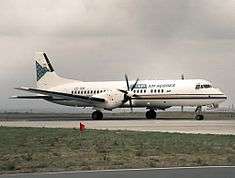SATA Air Açores Flight 530M
 CS-TGM of SATA Air Açores that impacted the Pico da Esperança | |
| Accident | |
|---|---|
| Date | December 11, 1999 |
| Summary | Controlled flight into terrain(CFIT) |
| Aircraft | |
| Aircraft type | BAe ATP |
| Aircraft name | Graciosa |
| Operator | SATA Air Açores |
| Registration | CS-TGM |
| Flight origin | Ponta Delgada |
| Destination | Santa Cruz das Flores |
| Passengers | 31 |
| Crew | 4 |
| Fatalities | 35 |
SATA Air Açores Flight SP530M was a flight of Portuguese regional commuter SATA Air Açores, that travelled between Ponta Delgada-João Paulo II Airport and Flores Airport, with intermediary stop at Horta, on 11 December 1999. At 9:20 a.m., the British Aerospace ATP Graciosa, collided with Pico da Esperança, in the central mountains of the island of São Jorge, resulting in the deaths of all passengers and crew, totalling 35 people.[1]
Accident
SATA flight SP530M departed Ponta Delgada-João Paulo II International Airport, on the island of São Miguel at about 8:37 a.m. Saturday morning for a flight to Santa Cruz das Flores, on the island of western island of Flores, with a stopover scheduled for Horta on the island Faial Island.[2] The weather en route was affected by a frontal system consisting of scattered cumulonimbus clouds, possible heavy showers, turbulence and strong winds from the southwest.[2]
During the course, the crew decided to alter their flight plan, opting for a route that included approach descent over the channel between the islands of Pico and São Jorge, to intercept the 250 degree VOR/VFL Horta radial.[2] Horta tower initially cleared the flight to FL100, but the crew then requested (and were cleared) to descend to 5,000 feet (1,500 m) with instructions to maintain visual contact with the island of Pico.[2]
During the descent, heavy rain and turbulence were encountered.[2] Seven minutes (9:17 a.m.) after initiating the descent, the ATP impacted the northern hillside of Pico da Esperança, at approximately 1,067 metres (3,501 ft) altitude on the island of São Jorge. The GPWS alerted the crew 17 seconds before impact.[2] No emergency call was received from the aircraft before it went down.
Aftermath
Rescue teams reached the wreckage more than four hours after the ATP crashed on Sao Jorge, where it scattered debris and victims across a dense ravine.[3] The search was called off after dark, and only resumed on Sunday, when the investigation team was sent to the isolated crash site from the mainland.[3] Seven bodies were recovered as rescuers using ropes and carrying stretchers, who scrambled over the steep mountainside before nightfall. Similarly, a thick mist shrouded the area, which was inaccessible to vehicles, making difficult the search operation.[3]
Although the Portuguese Air Force helicopters were on standby to winch out any survivors, the time spent meant that the searchers were only there to "collect the bodies and examine the causes of the accident", since there was "no hope of finding survivors", from the comments of Internal Affairs Minister Fernando Gomes.[3]
All SATA flights were canceled after the crash. Portuguese Prime Minister António Guterres, who was in Helsinki, Finland, for a European Union summit, cancelled a planned visit to Kosovo and headed straight for the Azores.[3] SATA arranged flights to the islands for international relatives of crash victims.[3]
Report
The final report by the commission of inquiry by the National Institute of Civil Aviation (Portuguese: INAC Instituto Nacional de Aviação Civil) concluded that the flight had made a slight deviation from its route to Horta, that was not perceptible by the flight crew. This deviation crossed the northern coast of the island of São Jorge, where it crashed into Pico de Esperança.[1] The crew "was completely convinced" that the plane was over the São Jorge Channel, and they were concentrated on meteorological conditions at the time of the collision. After hearing their impact warning, three seconds before the first impact, the copilot alerted the crew that they were "losing altitude and over São Jorge". But, even as the pilots increased engine output, the maneuver was "insufficient to overcome the obstacle".
The conclusion of the report indicated that there was a lack of rigour in maintaining the prescribed safe altitude, inaccurate dead reckoning, lack of cross-checking the information of the radio altimeter and barometric altimeter, and improper use of airborne weather radar as an additional ease of navigation, all of which contributed to the disaster.[2] The bad meteorological conditions on the day (which included clouds, moderate to heavy winds, with turbulence) and the lack of autonomous navigational aids aboard the aircraft (such as GPS), that could have determined their position, were also factors that contributed to the accident.[2] In regards to the aircraft, the report determined that the ATP was operating within the navigational conditions correspondent to the regulations and approved procedures outlined by aeronautical authorities.
José Estima, member of the directorate of the APPLA Associação Portuguesa de Pilotos de Linha Aérea (Portuguese Airline Pilots Association) stated that the factor that contributed to the accident of the SATA commuter was "a difficient [sic] quality and quantity of infrastructures to support aerial navigation". Referring to the credibility of the plane's pilot, APPLA indicated that the "pilot had flown for more than 20 years in the archipelago" and recorded that SATA pilots "are at the forefront, since they work in these adverse [local] conditions".
See also
External links
| Wikimedia Commons has media related to SATA flight 530. |
- Final report (in Portuguese) - GPIAA
- Accident details in Plane Crash Info
References
- Notes
- Sources
- Açores: Acidente com avião da SATA em S. Jorge, com 35 mortos, ocorreu há 10 anos] (in Portuguese), Visão on-line, 11 December 2009, retrieved 22 December 2014